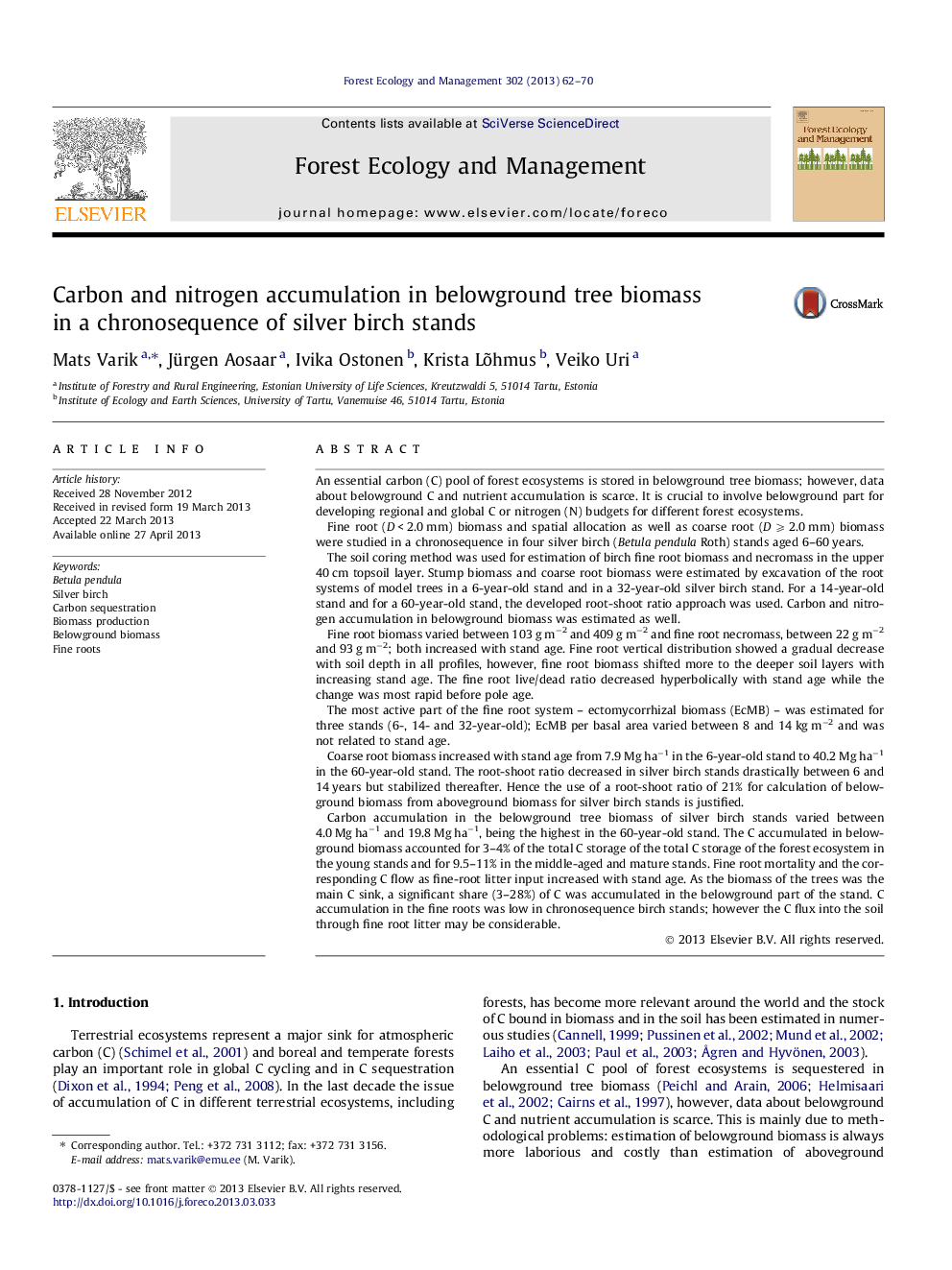| کد مقاله | کد نشریه | سال انتشار | مقاله انگلیسی | نسخه تمام متن |
|---|---|---|---|---|
| 87056 | 159230 | 2013 | 9 صفحه PDF | دانلود رایگان |

• The fine root live/dead ratio decreased with stand age.
• Ectomycorrhizal biomass per basal area varied between 8 and 14 kg m−2.
• Root to shoot ratio of 21% is reasonable for silver birch stands.
• Belowground part of a stand acts as a significant carbon sink.
An essential carbon (C) pool of forest ecosystems is stored in belowground tree biomass; however, data about belowground C and nutrient accumulation is scarce. It is crucial to involve belowground part for developing regional and global C or nitrogen (N) budgets for different forest ecosystems.Fine root (D < 2.0 mm) biomass and spatial allocation as well as coarse root (D ⩾ 2.0 mm) biomass were studied in a chronosequence in four silver birch (Betula pendula Roth) stands aged 6–60 years.The soil coring method was used for estimation of birch fine root biomass and necromass in the upper 40 cm topsoil layer. Stump biomass and coarse root biomass were estimated by excavation of the root systems of model trees in a 6-year-old stand and in a 32-year-old silver birch stand. For a 14-year-old stand and for a 60-year-old stand, the developed root-shoot ratio approach was used. Carbon and nitrogen accumulation in belowground biomass was estimated as well.Fine root biomass varied between 103 g m−2 and 409 g m−2 and fine root necromass, between 22 g m−2 and 93 g m−2; both increased with stand age. Fine root vertical distribution showed a gradual decrease with soil depth in all profiles, however, fine root biomass shifted more to the deeper soil layers with increasing stand age. The fine root live/dead ratio decreased hyperbolically with stand age while the change was most rapid before pole age.The most active part of the fine root system – ectomycorrhizal biomass (EcMB) – was estimated for three stands (6-, 14- and 32-year-old); EcMB per basal area varied between 8 and 14 kg m−2 and was not related to stand age.Coarse root biomass increased with stand age from 7.9 Mg ha−1 in the 6-year-old stand to 40.2 Mg ha−1 in the 60-year-old stand. The root-shoot ratio decreased in silver birch stands drastically between 6 and 14 years but stabilized thereafter. Hence the use of a root-shoot ratio of 21% for calculation of belowground biomass from aboveground biomass for silver birch stands is justified.Carbon accumulation in the belowground tree biomass of silver birch stands varied between 4.0 Mg ha−1 and 19.8 Mg ha−1, being the highest in the 60-year-old stand. The C accumulated in belowground biomass accounted for 3–4% of the total C storage of the total C storage of the forest ecosystem in the young stands and for 9.5–11% in the middle-aged and mature stands. Fine root mortality and the corresponding C flow as fine-root litter input increased with stand age. As the biomass of the trees was the main C sink, a significant share (3–28%) of C was accumulated in the belowground part of the stand. C accumulation in the fine roots was low in chronosequence birch stands; however the C flux into the soil through fine root litter may be considerable.
Journal: Forest Ecology and Management - Volume 302, 15 August 2013, Pages 62–70